Tips for Climbing Your First 14er
Hiking to the top of a a 14,000 foot mountain is a quintessential Colorado adventure. Here’s 5 simple steps to prepare for your first fourteener.
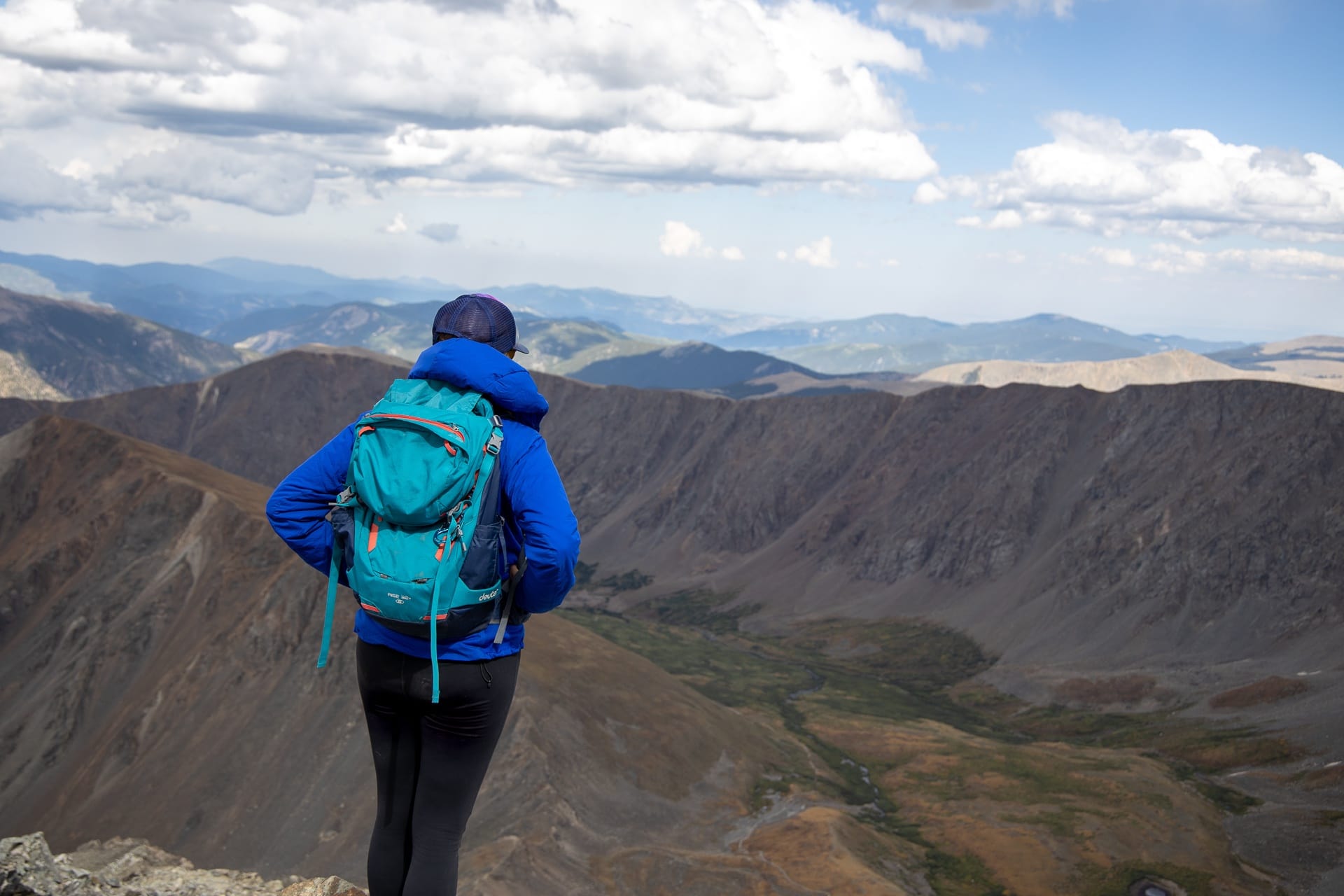
Whether you’re new to hiking or you’re a seasoned trekker, climbing a Colorado 14er is on many adventurers’ bucket lists. Not only do these peaks pose a physical – and often mental – challenge, but they also give you access to some of the most beautiful and remote areas in the state including the Sawatch Range, Front Range, Elk Mountains, and beyond.
As you can probably guess, though, climbing to the top of a 14,000+ ft peak is no walk in the park, and preparing for such a hike can seem daunting. I’ve climbed a few 14ers and while it isn’t easy, the reward of standing on the top is definitely worth the effort. So to help you get ready for your first 14er, in this post we share our best tips on how to plan and prepare for your hike. Now go get those legs ready!
This post may contain affiliate links.
Ready to climb your first 14er? Here’s everything you need to know for a successful hike to the summit.
This post is inspired by a guest post originally written by Ben Thomas of Wild Imagining in 2015.
What is a 14er?
A 14er (or fourteener) is a mountain that rises over 14,000 feet above sea level. While there are 96 peaks that top 14,000+ feet in the US, the 54 that are scattered across the western half of Colorado are collectively known as the 14ers and these peark are what we’ll focus on in this post.
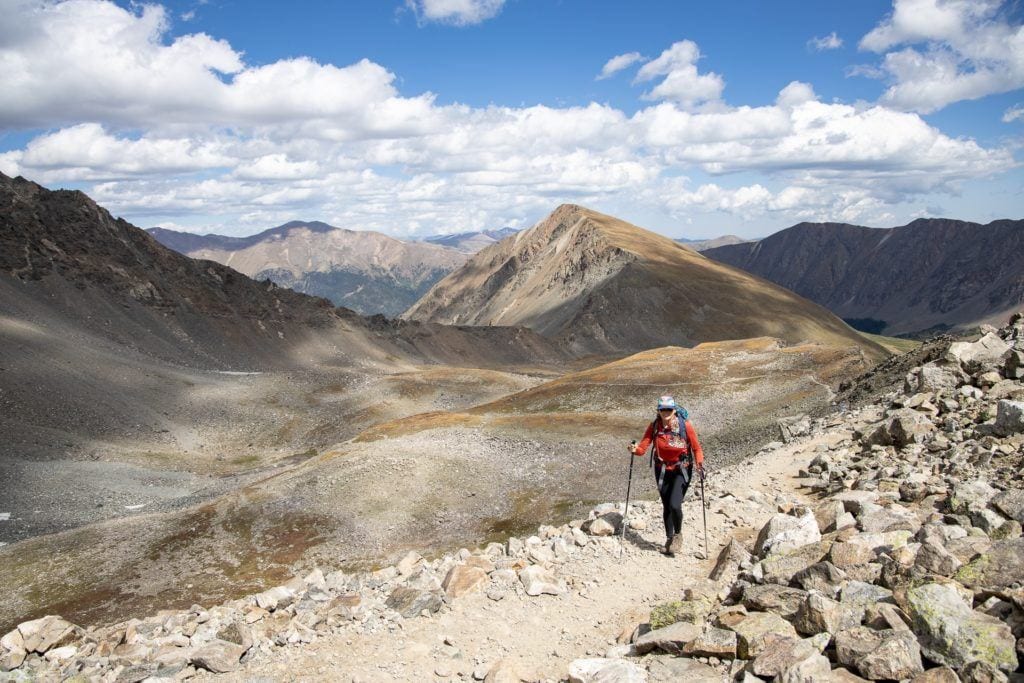
Save this post!
Enter your email & I'll send this post to your inbox! You'll also receive my weekly newsletter full of helpful advice for planning your adventures.
Choosing Your First 14er
Colorado’s fourteeners can range in difficulty from a challenging day-hike to full-on technical rock climbs that require a rope and a helmet. For your first 14er, it’s best to choose a peak that doesn’t require advanced technical skills.
There are plenty of resources out there to help you research trail options, but one of our favorites is 14ers.com which has detailed information on each of Colorado’s 14er’s. Some mountains have multiple trails to the top and we recommend choosing a trail labeled Class 1 or Class 2 since they’re the easiest, or go with the most common route.
If you’re not sure where to start, here are five great fourteeners for start with:
- Mount Bierstadt from Guanella Pass
- Mount Sherman from Four Mile Road
- Mount Democrat from Kite Lake
- Gray’s Peak from the Gray’s Peak Trailhead
- Handies Peak from American Basin
Also, be sure to check and make sure that you can get to the trailhead. Some trailheads are located on rugged dirt roads that require a 4WD vehicle. Others are on roads that most normal cars can handle. Double-check before you go!

Tips for a Successful 14er Hike
Find a buddy
For your first time hiking a fourteener, it’s best to have at least one other person to hike with. Finding someone who is experienced with fourteeners is best, but if you and a buddy want to tackle your first one together, make sure you are both prepared mentally and physically. Having someone along with you is especially helpful in case something goes wrong, be it altitude sickness, bad weather, or if you need someone to cheer you on at mile 8.
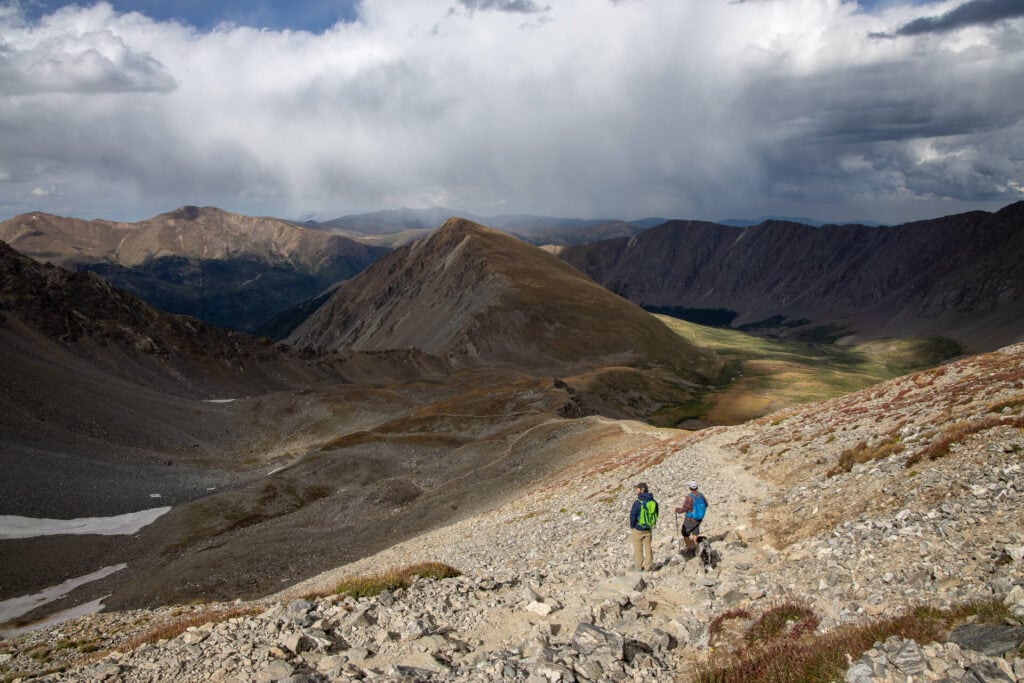
Acclimate to the elevation
One of the best ways to avoid altitude sickness is to get acclimated. Basically, this means you are allowing your body to get used to the altitude gradually. If you are traveling into Colorado from a lower elevation, try to spend at least one night either in Denver or in the mountains before you climb your 14er. The more time you spend at altitude, the better adjusted your body will become. Altitude sickness is the most common problem people run into on their first fourteener, so try to give your body a day or two to acclimate to reduce your risk of feeling sick.
Hydrate & Fuel Up
Along with acclimatizing, drinking plenty of water and fueling up with a healthy meal the night before can help set you up for success. Being properly fueled and hydrated before you push yourself at altitude is crucial to preventing altitude sickness.
Check the weather
Do a last-minute check on the weather conditions for your hike and make sure it is still safe to go. Weather can change very rapidly in the mountains, so if there’s a chance of a storm, it is a good idea to postpone. Above the treeline, storm conditions can bring lightening, snow, and strong winds and can be extremely dangerous. Listen to this podcast to hear about a group of hikers who had a scary weather encounter on a Colorado 14er and some lessons learned.
Get an early start
After all your planning and preparation, you’re ready to climb! Be sure to get an early start—we’re talking pre-sunrise. That way, you’re off the mountain (or at least back below treeline) before any notorious afternoon thunderstorms roll in. The rule of thumb in Colorado is to be off the summit and on your way down before 12pm. Keep an eye on the clouds and plan to turn around even earlier if the weather turns sketchy. Getting caught in a lightning storm above the treeline is downright terrifying, not to mention life-threatening.
Pay attention to how you feel
As you are climbing, pay attention to YOU. Check-in on your hiking buddy too and see how they are doing, but do not push yourself too hard in an attempt to keep up. Hiking at altitude is difficult. You’ll get tired faster, breathe harder, and your heart will be pounding.
Have fun!
Finally, enjoy yourself! Soak in all the big mountain views. It may be harder than you expect, but push yourself safely and it will all be worth it. Remember, you don’t have to reach the top in order to have fun! Yes, the summit is the obvious goal, but if the weather is moving in early or you feel sick, don’t push your luck. The mountain will still be around later; your job is to make sure you will be too.
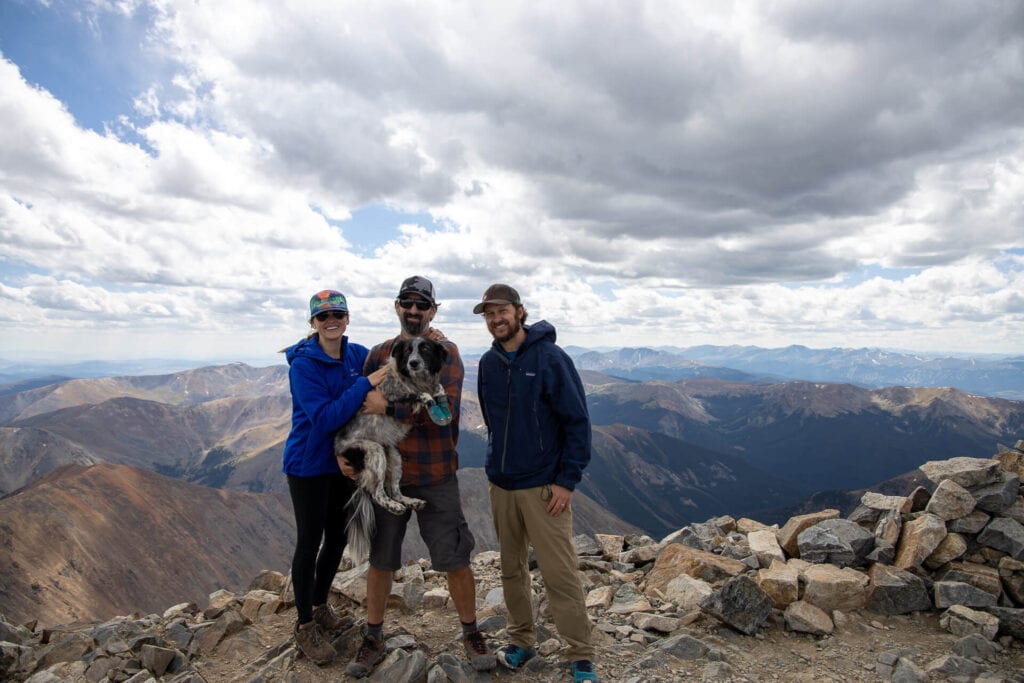
What Gear To Pack For Climbing a 14er
Now that you’ve chosen which peak to hike for your first 14er and we’ve covered some basic tips, it’s time to assemble your gear. While many 14ers can be done in half a day, you still need to have a backpack full of gear to hike them safely and responsibly. The weather can also change rapidly, so layering is crucial to your comfort. Below is a checklist of things you’ll want to bring with you, along with a few specific recommendations.
Clothing
Choose items of clothing that you can easily layer and that dry quickly. Avoid cotton clothing. Hiking up to over 14,000 feet will cause you to sweat and cotton does not dry fast enough. Wet clothes at the top will chill you to the bone, making for a miserable experience. For more specifics on what clothing to wear and pack, check out our post on What To Wear Hiking. Always bring extra layers (and waterproof ones) on a 14er hike in case the weather turns.
Hiking Gear
Since you’ll be hiking for several hours and gaining quite a bit of elevation, you’ll want to be prepared with the right gear. For a more complete gear list, check out our post on Day Hiking Essentials.
- Small first aid kit
- Swiss Army Knife or Leatherman
- Sunscreen
- Trekking Poles (your knees will thank you)
- Camera
- A comfortable and durable hiking backpack that can fit everything.
- A Garmin InReach
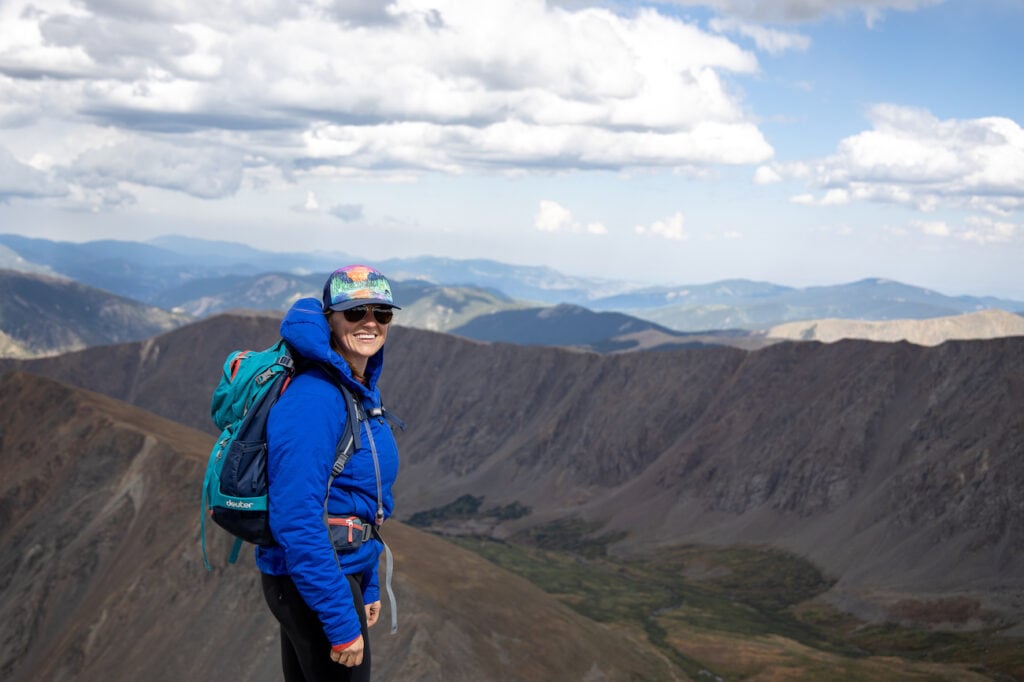
Food & Water
Carefully plan how much water and food you’ll. It’s no fun being hungry on the trail! Worse, not bringing enough water can be dangerous.
- Bring at least 3 liters of water per person. Consider bringing a pack that can fit a 3-liter hydration reservoir.
- Choose easy-to-eat snacks like bars and trail mix to eat along the way and pack a lunch to eat at the top. Check out this post for our favorite hiking snacks.
What peaks are you going to tackle this summer? Have you hiked any 14ers yet? Share your questions, tips, and experiences in the comments below.


I love geeking out over 14er accounts. Being in Pennsylvania makes tackling one fairly difficult, but I hope to get out west soon and see what all of the fuss is about. 😉 This is a good guide, so thanks to Ben and Jenna!
I used to live in DC, so I totally hear that! When you make it out west, come back and let me know. I wanna see pics! -Kristen
Great list and article, lovely pictures, and wonderful suggestions for beginner hikes.
I would also recommend bringing sunscreen. The exposure to the sun through the thin atmosphere at 14,000 feet doesn’t seem like a big deal when you’re on the climb, but burns happen quickly and quietly. Even if you’re wearing long sleeves and pants, cover your face with plenty of high SPF sun protection.
Great addition Dan! I’m going to update the post right now. Really appreciate the comment and you stopping by my blog! -Kristen
Ah, yes!! Thank you Dan and thank you Kristen for updating the post! Somehow sunscreen got lost in one of our edits, but it is SO important. I have fried from not reapplying, I can’t imagine a day completely without it at altitude.
Don’t forget your lips and eyelids when protecting from the sun!
Great story. I’ve done a couple 14ers in South America. This is all good advice.
Thanks Tom! I’m glad you liked the post! I bet those 14ers in south america were amazing. -Kristen
Great article! Hopefully I can do one of the 14er for the first time. I would also recommend to get the book “freedom of the hills” it’s a great guide for beginners in mountaineering.
Thanks for the tip Angel. I’ll definitely check that out.
Great article – and I too share enthusiasm for 14ers, having my own site dedicated to Colorado’s 100 highest mountains over at http://www.100summits.com
I just wanted to give you some quick advice – you might want to reach out to photographers before using their photos on your blog. Most, like me won’t mind at all, but if the photo you use is licensed by a stock photo agency you could rack up some fees and negative press.
Feel free to use the one of mine here, no problem there! 🙂
Cheers and keep up the good work.
Matt – Thanks for stopping by and thanks for the tip. Most of the photos featured on my blog are my own. When I do source from others, I only use photos on Flickr that have a creative commons license. I’ll definitely check out your website though. Thanks again! Kristen
Awesome article. I’m using your site to prepare for my through hike on the JMT next month! Hiking 14ers is getting me prepared.
We’ve built an app to help you plan and save for your first or next 14er: Colorado 14ers on iOS https://appsto.re/us/ddX4ab.i
Great tips! I’ve done one 12K hike in CO 6 years ago, and a hike-to-ski in Breck this past year. Heading back to my heart’s home and tackling a 14er in September. I’m so stoked, but am concentrating on the workouts for now. This list will save me time worrying about prepping in a few short months.
aaahhh, I’m so excited.
I would also add committing to a regular cardio regime and bagging a couple 13ers in preparation (if time allows) .
Doing my first 14er this summer with my boyfriend! This article was an easy, quick read with great tips. We’ll be doing Mt. Elbert and camping overnight afterwards. Thanks for the advice 🙂
Awesome! Let us know how it goes!
Great article! Thank you!
MT. ELBERT — LEADVILLE, CO | Our family of five will be making the climb! Can’t wait!
My wife and I recently started climbing all the 14ers. We are at 12 so far, and she designed a cool board to track them! You can visit Whake Studios to see the board!